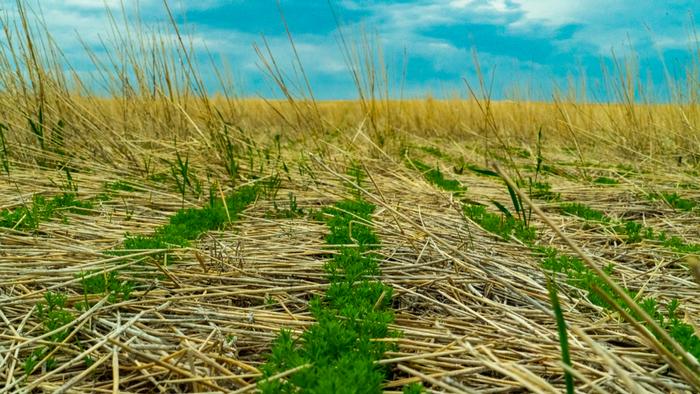“Soil is our livelihood and we better protect it, or we’re screwed.”
by Emily Stifler Wolfe, Montana Free Press
Wind and water have eroded Montana soils since the first plow turned earth on the Northern Plains more than 150 years ago, taking with them one of the state’s most important resources. Since then, tillage, plus the fertilizer and pesticides common in industrial agriculture, have continued to degrade the soil that agriculture depends on. With climate change threatening almost 25,000 Montana agricultural jobs in the next 50 years, many farmers, ranchers and researchers believe the status quo is no longer adequate. And though conventional farming continues to account for the overwhelming majority of Montana’s $4.6 billion ag sector, things are shifting.
Part I of this series, supported by the Solutions Journalism Network, explores two responses to soil degradation in the age of climate change: organic and regenerative farming systems.
Organic has been a USDA certification since 2002, while regenerative lacks a codified or even consensus definition, but generally includes a suite of techniques like cover cropping, crop rotation and livestock integration that decrease erosion, improve biodiversity and capture carbon. Both systems have challenges and shortfalls, which are considered here, but a growing number of Montana producers are using them to build topsoil, become more resilient to drought, capture carbon and increase profits.
Aslight haze hangs on the blue horizon above Ledger Road, 50 miles north of Great Falls in north-central Montana. Rectangles of spring crops and native grasses glow green alongside the dried straw of last year’s fallow. Forty miles north, the Sweetgrass Hills rise 3,700 feet above the high plains.
A mile down a side road, past another farm, the home place at Tiber Ridge Farm is an oasis of trees, farm buildings and birdsong. The farm sits in the geographic center of the Golden Triangle, a 4,000-square-mile area between Great Falls, Havre and Cut Bank best known for producing high-protein wheat.
In the driveway, John Wicks starts his semi, a Freightliner with 800,000 miles he bought used in 2007. That was right after his dad died and Wicks left Montana State University in Bozeman to help his mother on the farm where he grew up.
“It’s got a [fuel] leak, a pinhole somewhere that’s sucking air,” Wicks says, stepping away from the truck while it warms up. “So when I let it sit for a couple days, it’s hard to start.”
While he waits, Wicks talks to his wife, Gwyneth Givens, who’s building new raised beds for their summer garden with the hired hand, Peyton Cole.
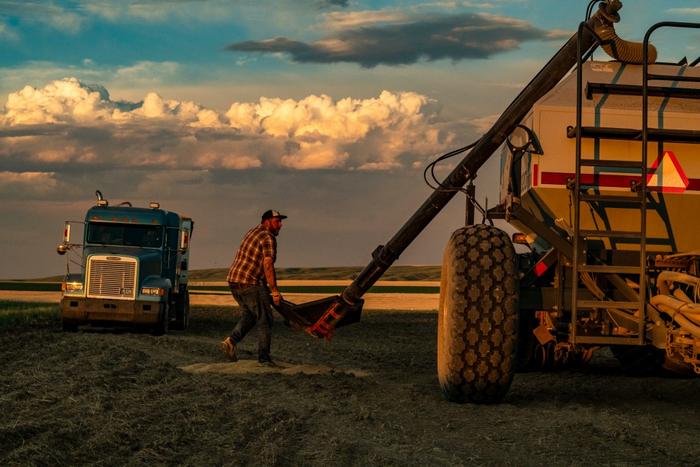
John Wicks puts away the fill auger on his air cart after planting the last of his organic barley at Tiber Ridge Farm north of Great Falls in early June 2021. Credit: Jason Thompson / MTFP
Once the truck is warmed up, Wicks climbs back into the cab and pulls left out of the driveway. As he descends toward Pondera Creek, the eastern end of Tiber Reservoir emerges into view between crumbling sandstone bluffs. In front of it, across the drainage, wind blows dust off a hilltop.
Wicks frowns. He and Givens planted those hilltop fields with winter wheat, but some of it died in a cold snap, making the ground susceptible to wind erosion. Like the majority of their neighbors in the Golden Triangle, they are dryland farmers, meaning they don’t irrigate.
“The tillage we’re doing is 2” deep — trying not to get in there and mess with our microbiome,” Wicks says. Traditional tillage, he explains, rips four to five inches down, destroying the interconnected web of plants, animals and microorganisms that make up a healthy underground ecosystem, which in turn provides nutrients for crops. Used for weed control and to loosen the soil for planting, tillage combined with drought caused the Dust Bowl of the 1930s and continues to cause severe erosion in Montana and elsewhere on the Great Plains.
Located 26 miles from Chester, population 1,099, Tiber Ridge Farm is in one of Montana’s most significant agricultural areas. The nine counties that roughly form the Golden Triangle grew 61% of the state’s winter wheat and 58% of its barley in 2019, and were second only to northeastern Montana in lentil production. In 2018, producers here grossed $1.16 billion, more than a quarter of the state’s annual $4.4 billion gross farm and ranch income.
As in the rest of Montana, most Golden Triangle farmers use the “conventional” techniques of modern industrial agriculture. Aiming for the highest crop yield possible, these are generally monocropping systems reliant on pesticides (including herbicides, insecticides and fungicides), synthetic fertilizers and genetically modified seeds.
In contrast, Wicks and Givens are borrowing methods developed by indigenous farmers millennia ago. They fight weeds and pests by rotating which crops they seed in a plot each year, for example, and by planting cover crop mixes of vegetables, grasses and clover that also return nitrogen and biomass to the soil and protect against erosion. They also lease land to neighboring ranchers, whose grazing cattle aerate the soil with their hooves and add organic matter and nutrients via manure.
“When I was farming [before], I sprayed, and I liked what I thought was a really clean field. It took me a little mind-changing to realize that [the] soil was just dead … And I think that’s one of the things a lot of farmers struggle with, is admitting that maybe you weren’t doing the best practices.”
With climate change threatening almost 25,000 Montana agricultural jobs in the next 50 years, many farmers and ranchers are realizing the status quo is no longer adequate. And as a movement toward ecologically based agricultural practices gains ground nationwide, an increasing number of Montana producers are building topsoil, drought resilience and profits by integrating practices like organic or regenerative systems.
Both approaches are expanding in the state. Because organic is a USDA certification, it’s easy to measure its growth in Montana, which is second only to California in certified organic acreage. Regenerative, meanwhile, lacks a codified or even consensus definition, but generally includes techniques like cover cropping, crop rotation and livestock integration. Although regenerative approaches are harder to track, one likely indicator, cover cropping, is up by 489% over the last 10 years in programs supported by the USDA’s Natural Resources Conservation Service.
For producers working to improve their farm’s soil health and economic stability, transitioning to an organic or regenerative system is a long game. They’re investing not only in this year’s yields, but in the future of their farms, their communities, and the system that produces food for both U.S and global consumption. A growing body of research also points to regenerative agriculture’s ability to sequester carbon, although how much is yet to be determined.
But farmers and ranchers can’t overhaul America’s food system themselves, and they might not need to. On June 8, the USDA announced a more than $4 billion investment in the nation’s food system aimed at strengthening supply chains, creating new market opportunities, responding to climate change, helping underserved communities and supporting good-paying jobs. Depending on how those funds are allocated, they may allow more Montana farmers to build soil health and add economic resiliency to their operations.
TRANSITIONING TO ORGANIC
Wicks was 21 when he left MSU and returned to the family farm. At first, he and his mother farmed about 1,300 acres, all wheat.
“A lot of years, we were going backwards and rolling our debt over, just building up our long-term debt,” said Wicks, now 36. “It was really scary.”
Wicks had considered transitioning to organic for years, but he and his mother knew it was a risk. When Givens moved to Tiber Ridge, her support gave him the extra push to make it happen.
Givens, 35, grew up on a seed-cleaning operation in Big Sandy, 90 minutes east of Tiber Ridge. After attending culinary school in Denver and working as a pastry chef at a yacht club in Florida and the Northern Hotel in Billings, she moved to the farm in 2015. That year, they planted a home garden and cleaned up the farmyard. She got jobs cooking at a bar in Hingham and a coffee shop in Fort Benton, but quickly realized it didn’t make sense to drive an hour each way to work for minimum wage when there was plenty of farmwork to do. It just had to pencil out.
“But the farm had to make money to support a family, so that’s where that transition started to really make sense,” Givens said.
The couple began experimenting with organic crops in 2016. They planted 700 acres of organic red lentils and spring wheat. Wicks didn’t think they’d stick with it, but he wound up having fun farming that way, and at year’s end his books showed the organic crops were the most profitable.
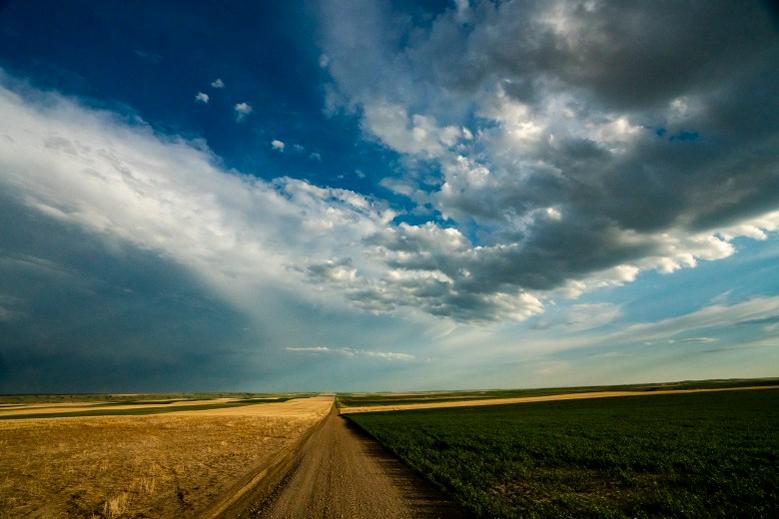
Fields of alternating crop and chemically forced fallow south of Tiber Reservoir. “Chem fallow” has been common in Montana since the herbicide Roundup became readily available in the 1990s, because the technique preserves water and prevents erosion, but as weeds become increasingly resistant to herbicide, farmers are forced to use more each year. Credit: Jason Thompson / MTFP
Plus, he was getting tired of dealing with the chemicals, mostly the herbicide commonly known by the brand name Roundup. In 2015 he contracted chemical pneumonia, caused by inhaling toxins. He knew cancer was a concern (“most farmers just assume that’s what’s going to get them,” he said), but it was still several years before the class-action lawsuit against Roundup’s manufacturer,
Soon after they began experimenting with organic on part of the farm, weeds became so resistant to Roundup that chemical companies instead suggested Paraquat, which is lethal to humans in even small amounts. At that point, Wicks and Givens decided they were over it. In 2018 they went cold turkey on both pesticide and fertilizer, reducing their operational costs by $200,000 from the previous year, even with an added 1,000 acres in production.
Wicks and Givens earned organic certification for their entire farm this year, and they’re now applying for the new regenerative organic certification.
In the five years since they started down the organic road, Wicks and Givens have encountered obstacles. Insurance isn’t available for some specialty crops like Einkorn, for example, and they have to truck their barley to Anheuser-Busch’s organic grain elevator in Idaho Falls, rather than dropping it off at the company’s elevator an hour away in Conrad, which accepts only conventionally grown crops. And because organic takes more time and management overall, they had to really work for it.
After growing up on the farm and studying conventional agricultural practices at MSU for a year, the toughest thing, Wicks said, was changing his mindset.
“When I was farming [before], I sprayed, and I liked what I thought was a really clean field,” Wicks says over the rumble of his tractor. “It took me a little mind-changing to realize that [the] soil was just dead. So, starting over from that, realizing what I was doing wasn’t great. And I think that’s one of the things a lot of farmers struggle with, is admitting that maybe you weren’t doing the best practices.”
INVESTING IN RURAL COMMUNITIES
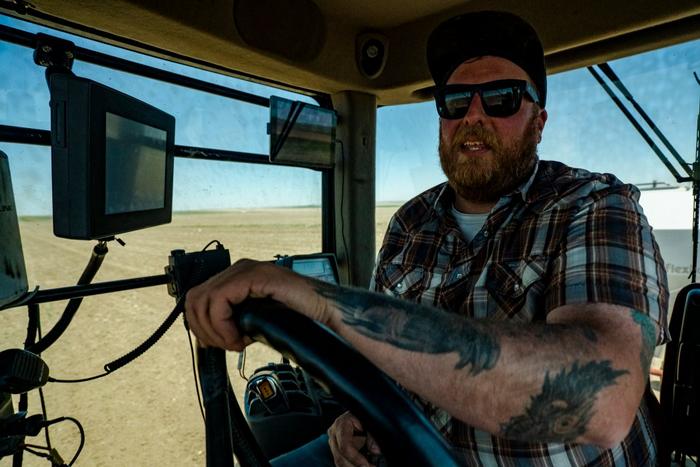
John Wicks drives his tractor during the last barley planting of the season. On this day he planted about 330 acres of the 600 acres he put in barley this year. He and his wife, Gwyneth Givens, are planting 4,500 acres in 2021: 3,000 acres in cash crops, and 1,500 acres in cover crops. Credit: Jason Thompson / MTFP
Between cash and cover crops, Wicks and Givens are planting about 4,500 acres this year. Some of that land is leased from Wicks’ mother, who retired in 2019, and the rest they lease from neighbors. They’ve contracted most of the barley to Anheuser-Busch, though they’ll sell some to nearby Hutterite colonies for chicken feed. They’re also growing lentils, chickpeas, Kamut and Einkorn for smaller mills including Timeless Seeds and Montana Flour and Grain, both based in Montana.
Their yields are smaller than their conventional ones were, but Wicks said it’s worth it. Previously, they were at the mercy of international commodity markets, as well as ever-increasing seed, chemical and fertilizer prices. Organic producers often have more leverage, because they usually grow a diverse range of crops and sell directly to processors. Plus, many Montana organic grain and pulse growers forward-contract their crops, meaning they lock in a per bushel price before even planting. Wicks and Givens often sell their organic crops for two to three times the price of conventionally grown ones.
In turn, they spend locally, buying groceries in Chester, beef from a neighbor and equipment from local dealerships. Their equipment dealer, Gary Blonde, sees the economic ripples of organic and regenerative, too. An organic farmer himself, Blonde sells farm machinery for Tilleman Equipment in Havre, where he says more people are buying tools specific to organic and regenerative farming.
JOURNEY INTO REGENERATIVE AGRICULTURE
Lack of jobs and loss of soil fertility in the Golden Triangle run parallel to each other. Once incredibly healthy, the soil here formed during the 11,000 years after the last Ice Age. As the prairie sod thickened, it absorbed water and carbon, becoming ever richer, said Tim Seipel, an MSU agricultural ecologist and extension specialist. Seipel compared that original sod to old-growth forest.
“We cut the prairie sod, and then we basically mined the soil the sod had made, and now the mine is starting to go dry,” Seipel said. That phenomenon is occurring on farmland worldwide as erosion, salinization, acidification and nutrient loss degrade the soils humans need to produce food.
“Now we’re presented with the opportunity to rebuild the soil and put it back together,” Seipel said. “Soil is our livelihood and we better protect it, or we’re screwed. The writing is on the wall.”
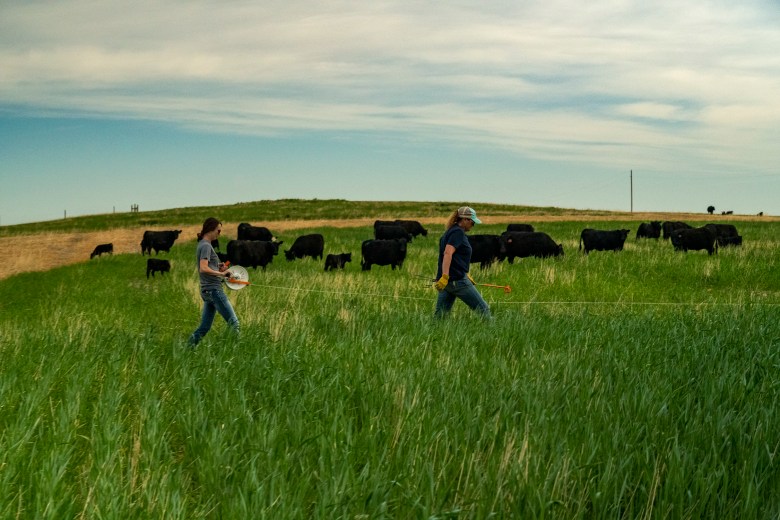
Wendy Fauque (right) and Willow Wieskamp set up a temporary electric fence at Happy Steer Ranch. They move the cows daily as part of an intensive grazing system. The animals fertilize the soil with manure and aerate it with their hooves, while the Fauques are able to make a profit by grazing their cover crops. Credit: Jason Thompson / MTFP
Enter regenerative agriculture.
Set between Interstate 15 and the Sweetgrass Hills, Korey and Wendy Fauque’s 5,000-acre operation is a landscape of contrasts. From the ranch headquarters, four miles south of Sunburst and 23 north of Shelby, you can see oil rigs, wind turbines and the sharp rise of the Rocky Mountain Front.
In the closest pasture, a herd of 70 cow-calf pairs laze in the grass. Wendy paces 50 steps beyond a temporary electric fence and unspools a hot wire. Willow Wieskamp, the hired hand, stamps in fence posts. Wendy seeded a rye-wheat hybrid called triticale here last October, and the ungrazed grass is already over knee-high. Between the three of them, they move the fence daily, aiming to graze roughly half of the grass before moving on. The cows ramble over, lowing for the new feed.
As Wendy and Wieskamp set up the fence, Korey pushes a shovel into the ground and pries up a blade of soil.
“These roots are extruding sugars to feed the [soil] biology … like mycorrhizal fungi and bacteria,” he says, breaking apart a mass of roots and earth with his hands. “We’re really short on the fungi part, because we killed all that with the chemicals over the last 40 years of farming. We just hammered and hammered and hammered on it.”
The Fauques (pronounced “Fauks”) are using regenerative practices to turn that around. The tiny world of roots, earthworms and insects crumbling through Korey’s fingers is evidence it’s working. Aiming to improve fertility and biodiversity and capture carbon, they use many of the same techniques as Wicks and Givens, with one main difference: Instead of tilling to fight weeds, the Fauques spray herbicide, albeit much less than a typical conventional grower.
Korey, 43, grew up on the ranch, and attended school in Sunburst, population 360. After graduating from MSU Northern in Havre, he worked as an agronomist at an agricultural co-op in Cut Bank, scouting farmer’s fields, sampling soil and advising on fertilizer ratios and herbicides. That’s where he met Wendy, 44, then the co-op’s finance manager and commodities broker. Raised on a Nebraska cattle ranch, Wendy moved to Montana after earning a masters degree in agricultural economics and agribusiness from the University of Wyoming. They married in 2003, purchased a crop insurance business, and soon added agrochemical sales and consulting to their portfolio. When Korey’s dad retired in 2012, they took over what’s now Happy Steer Ranch.
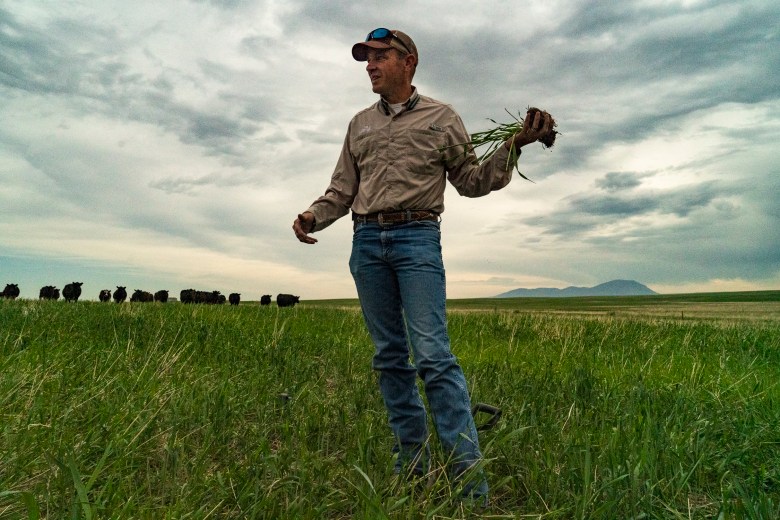
Korey Fauque holds a chunk of soil from the 5,000-acre Happy Steer Ranch, a crop and cattle operation south of Sunburst that he shares with his wife, Wendy. The Fauques are using regenerative agricultural techniques to improve their soil health, which Korey says was “hammered” by conventional practices that relied on heavy pesticide and fertilizer use over the last 40 years. Credit: Jason Thompson / MTFP
Starting out, they followed the standard practice of alternating wheat and barley with “chem fallow,” which means they grew a crop one year and then killed everything with Roundup and left it unplanted the following year. After that, they planted directly into the old crop residue with a “no-till drill” that slices diagonally into the soil and inserts seeds directly into old crop residue. Because there were no live crops using water during the fallow year, the method preserved soil moisture, essentially giving the next year’s crop two seasons’ worth of water.
No-till has been common on dryland farms in Montana since Roundup became readily available in the state in the 1990s. It replaced tilled fallow, in which farmers plowed last year’s crops under and left a field of bare dirt. At the time, chem fallow/no-till was considered revolutionary because it reduced erosion by leaving the dead straw in place and eliminated plowing.
At first, the Fauques sprayed 16 ounces per acre, but as the weeds became resistant they bumped up to 24 ounces, and then a quart. Like Wicks and Givens, they drew the line at Paraquat.
Around that time, their neighbor Griff Bye was one of the first in the area to experiment with cover crops and integrating livestock, and he often stopped by to talk about what he was trying. In those conversations, the Fauques realized they could improve the soil by planting pulses or cover crops, and make money by grazing those same cover crops, instead of spending so much on Roundup. After attending a Natural Resources Conservation Service training and watching soil health videos on YouTube, they stopped fallowing and began planting legumes and cover crop, and reducing pesticides and fertilizer. Five years in, soil sampling showed increased organic matter and microbial life. Next they devised a mobile water trough that pumped water to their cover crop plots and native pastures, allowing them to move their cattle daily, a practice known as intensive grazing. In 2019, they switched to a smaller, hardier breed, Aberdeen Angus, and began calving in late spring instead of winter to reduce stress on the animals. Now, they’re planting pollinator strips to attract birds and insects like bees, which are integral to crop farming but in decline, in part due to pesticide use.
“The more you start trying stuff, the more you want to try stuff to get it turned around,” Wendy said.
AN IMPERFECT SOLUTION
Even when used minimally, tillage and pesticides both come with clear downsides. But no one has figured out how to completely eliminate either at scale and over time, a goal Korey calls the “Holy Grail.” With new technology and research — including a current MSU study on naturally occurring weed pathogens based on a similar biocontrol project in Kenya — a no-till organic system might one day be possible.
In the meantime, public interest in regenerative agriculture is growing rapidly. Around since the 1970s, the term only recently became part of the lexicon.
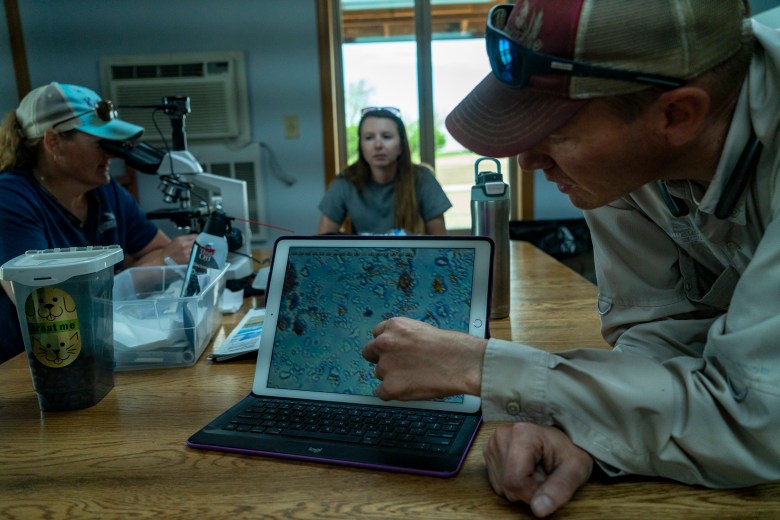
Wendy Fauque looks through a microscope at a soil sample, while Korey Fauque points out the microbial and insect life she’s seeing on a computer screen. Credit: Jason Thompson / MTFP
Mainstream media coverage has increased dramatically in the last two years, as private companies and now the Biden administration consider paying farmers to capture carbon as part of carbon markets. Alongside that rising profile come critiques. Skeptics are raising concerns ranging from the limited scientific proof of carbon capture rates to the potential for greenwashing and the barriers to Black, Indigenous, migrant, women and other minority farmers who are integral for regenerative agriculture to thrive in the long run.
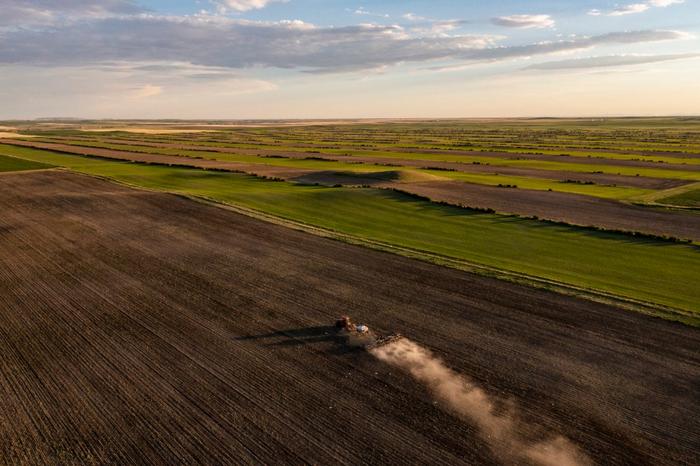
John Wicks planting organic barley at Tiber Ridge Farm in June 2021. Credit: Jason Thompson / MTFP
Still, they estimate that about 50% of operators in Toole County are adopting regenerative practices on at least part of their land. Some are doing it because they can’t afford synthetic fertilizers and pesticides, Korey said, while others are responding to herbicide-resistant weeds. In addition, Korey says, a new generation of young farmers recently returned to the area, and many are open to trying new things.
“I think ag is headed that way, but there’s so much money in the chemicals and fertilizer and in the way things are done that it’s hard to get away from that and figure out how to find those markets,” Wendy said. “At least right now we’re figuring out a way to improve our ground and our animals’ health. And I think it’ll eventually pay us back — even if it’s not financially — if we can just keep making a living and producing better products.”
Reprinted with permission of Montana Free Press.
To view original article, visit:
Organic & Non-GMO Insights August 2021

